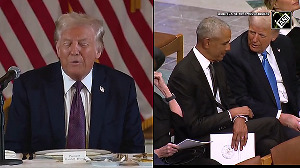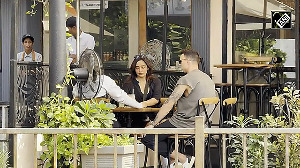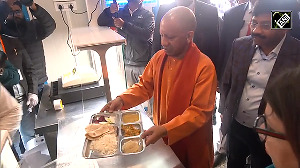 After the elite National Security Guard took over the operation against the ten terrorists who attacked Mumbai on November 26 last year, they neutralised the eight terrorists and took control of the Trident hotel, Nariman House and the Taj Mahal hotel.
After the elite National Security Guard took over the operation against the ten terrorists who attacked Mumbai on November 26 last year, they neutralised the eight terrorists and took control of the Trident hotel, Nariman House and the Taj Mahal hotel.
In an interview with rediff.com's Vicky Nanjappa, the NSG's then director general J K Dutt looks back at the dilemmas, decisions and delays that the force faced during the terror attacks.
You have said that there could have been more than ten terrorists in Mumbai on the night of November 26. What prompted you to come to that conclusion?
It is for the investigating agency to verify that fact. I was the director general of the NSG at that point of time and I was just depending on the inputs given to me by the Intelligence Bureau and other police sources. I did not have independent sources with me to verify this information.
On the basis of the operations conducted by me, I feel that there were more than ten terrorists. Looking at the mayhem and havoc that was created, I felt there were more than ten terrorists.
If there were more than ten terrorists, did the NSG fail to capture them?
That is not correct. We managed to recover all the weapons and ammunition after the operation. I was told by senior officials that I needed to account for ten AK-47 rifles and we would be able to determine the number of terrorists by the number of weapons. We managed to recover all the weapons.
However, two were recovered by the police who had managed to kill one terrorist and nab another.
Since I felt there could be more, I had also told the local authorities to screen every hostage carefully, since we felt that some could have been staying as guests. Our job was to neutralise the terrorists and get the hostages out alive.
Once again, I would like to state that regarding the number of terrorists, it is best for the investigating agency to answer this question.
The report about local support to the 26/11 terrorists has been denied by the investigating agencies. What is your take on this matter?
This again is a question to be posed to the investigating agencies. I personally feel that an operation of this scale would not have been possible at all unless there was local support.
One cannot rule out this aspect at all. We were called in to neutralise the terrorists and we did our job.
Let us come to the most talked about subject at that time -- the delay in the NSG team reaching Mumbai. There was also talk of an aircraft not being available. Could you please take us through what exactly happened?
Yes, I know that a big question is whether the death toll would have been lesser had the NSG reached earlier. When our team reached Mumbai, we did not know how many terrorists were there.
In fact, there was no definitive information and we were told that there may be anything between five and 30 terrorists. But that was not the main concern as irrespective of the number of terrorists, we were ready to deal with them.
Please explain why the NSG team was delayed in reaching Mumbai.
The last time the NSG was pressed into similar service was at during the Akshardham temple terror strike. There, the NSG team reached the next day, but such a hue and cry was not raised about that. Maybe because the death toll was lesser there and there was no senseless shooting going on.
The aircraft was available. We did not have a system to keep everything on standby at all times.
The aircraft had to be readied and the NSG had to carry extra arms and ammunition with it. All this had to be loaded on the aircraft and our commandos did it by themselves. This took some time.
How did the authorities in Mumbai respond? Were they late in calling in the NSG?
Initially, the Mumbai police thought it was a gang war and hence they had geared up to fight that battle. They realised it was a terrorist attack only after a while.
I would like to make one thing clear -- the NSG cannot act suo motu. Law and order is completely a State subject. The NSG cannot walk into states and undertake operations on its own.
We had to await orders from the state government before we could even go to Mumbai. The siege of the city commenced at approximately 9.30 pm and we received a request at midnight. However, I had told the commandos to be ready and had already moved them to the airport, before the request came in.
After you reached Mumbai, were the state authorities helpful? There was talk about how the transport provided to the commandos was below par.
When we reached Mumbai, the buses were ready to carry us there. I know there were reports stating that we were ferried in BEST buses, but that was not my concern at all.
The fact is that there was transport to ferry us to the target spots. More importantly, after the NSG arrived, we ensured that not a single hostage was killed.
What do you think of the way the Mumbai police handled the situation, before the NSG came in?
The security forces should have pinned down the militants. It was clear that they had inadequate equipment and expertise. They had not undergone counter-terror training.
They were on the backfoot with no protective gear on their bodies and no sophisticated weapons on them.
How would you describe the 26/11 operation? Was it an easy one compared to other operations that the NSG has undertaken?
The operation was not an easy one. The Marcos (the Indian Navy's Marine Commandos) were called in and they managed to have a brief skirmish with the terrorists at the Taj Mahal hotel.
However, when the NSG came in, there was no information as to where the terrorists were hiding within the hotels.
The first step taken by us was extremely crucial and I had it in my mind that at any cost, I did not want the commandos to become victims.
We needed cover at that point of time. When we stormed the hotels, we were aware of the fact that the terrorists could deceive us and we needed to be on our guard.
The fact is that we took time to establish contact with the terrorists, but once that was done we did not let them get out.
Has the NSG faced a tougher situation in the past?
This was an once-in-a-lifetime type of incident. I would say that this operation was unique and so was the incident. Hotels were targeted for the first time. There were hundreds of rooms. This was not an operation out in the open, where we could have cover.
It was difficult since the terrorists could have been extremely deceptive.
What was the first thing that came to your mind once the NSG landed in Mumbai?
The most important thing was to rescue the hostages. Establishing contact with the terrorists was also important. Each and every room had to be checked. We did not have exact information as to where these terrorists were hiding in the hotels. If we did, we would have stormed the hotel.
What about the layouts of the targets? Were detailed layouts provided to you by the authorities?
Yes, they were given to us. However, the NSG was not looking for extremely detailed layouts. It was important for us to know the nature of the rooms. We wanted to know where the store rooms and the meeting halls in the hotels were, then we would not have to waste time in checking these rooms.
The Taj operation took three days to end even after the NSG arrived. What was the reason for this?
As I pointed out earlier, this was a hostage situation and our primary concern was to get the hostages out safe. The operation was not just restricted to three places for the NSG -- it was going on in five places.
Not only did we have to check the Hotel Trident but the adjoining tower had to be combed too. The case was the same at the Taj Mahal Hotel, where we had to check the tower along with the heritage building.
We had an operation to undertake at Nariman House too.
How long was it before the NSG actually established contact with the terrorists?
We had rescued the hostages and ensured that there were no further casualties on November 27 itself. At 3 am on November 28, we established contact with the terrorists at Hotel Trident and by 7.30 am, we neutralised them.
On the same day, we managed to neutralise the terrorists at Nariman House.
On November 29, we completed the operation at the Taj.
Why did the operation at the Taj take such a long time? Was it the toughest operation?
At the Taj, the terrorists kept moving between floors. There was a spiral staircase connecting the first and the second floors that all of us thought was a service staircase. The terrorists kept shuttling between floors via this staircase.
They were extremely deceptive at the Taj. We had to tread carefully since I did not want any causalities.
There were over 400 rooms and we needed to comb each room carefully. We could take no chances. We did not want to storm the hotel and start battling the terrorists until we had checked each and every room and ensured that no guest was trapped inside.
I don't want to compare and comment on which operation was tougher. All operations were hard and ultimately successful for us.
There was talk that the NSG could have released gas to smoke out the terrorists. Did you consider this option?
Gas was never an option. This was a hostage crisis and that would have only increased the number of civilian casualities.
At any point during the operation, did you feel that you could nab the terrorists alive? Was such an attempt made by the NSG?
We did try and tell them to surrender. In every operation, there is a stage when we know that we have almost won the battle. It happened in Mumbai too.
When we reached that stage, we did tell them to surrender. But they were adamant and each time we told them to surrender, there were nothing but abuses from them.
They repeatedly hurled abuses and got more aggressive. When we tried again, they started intense firing. Then we realised that we were making a futile attempt, so we went ahead and killed them.
The fact they refused to surrender is an indication that they had it in them to go on for longer. Do you share the same view?
After we had finished them, we went around recovering arms and ammunition that belonged to them, and it was clear that they had enough ammunition to fight for another two days.
Do you think India has learnt its lesson following this attack? Are we better prepared to ward off a terror attack of this nature?
There is no fool-proof arrangement to ensure that there would not be such attacks in the future. There are various aspects that need to be changed.
Every wing in the government set-up needs to pull up its socks. The laws and the rules need to change, the inventory of the security and defence forces need to improve. The security forces need to be strengthened.
Image: J K Dutt. Photograph: Saab Press










 © 2025
© 2025